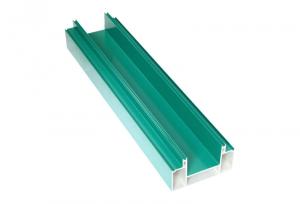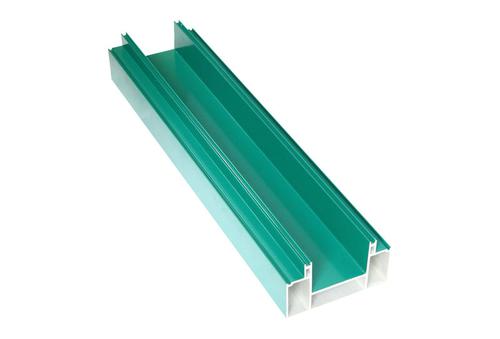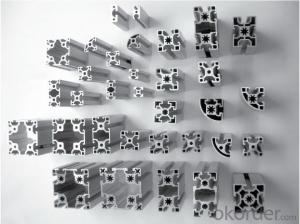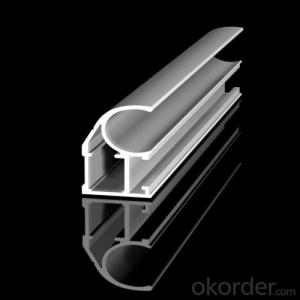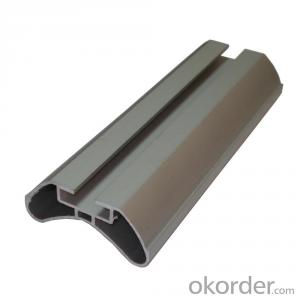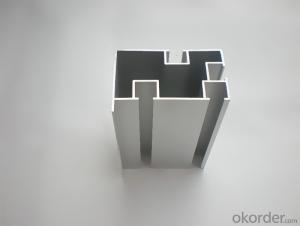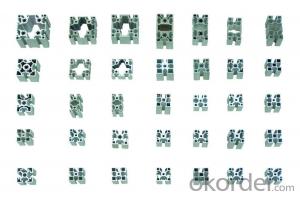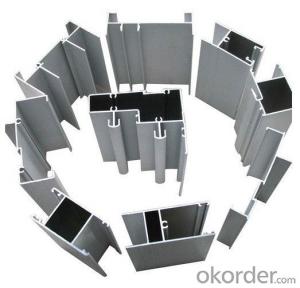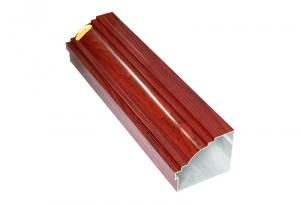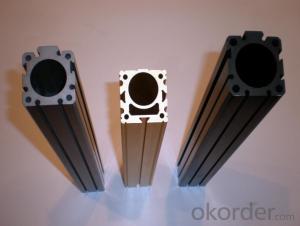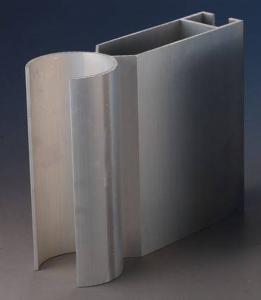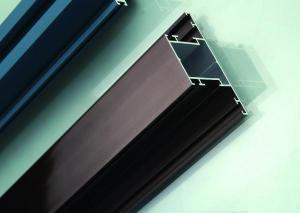Powder Coated T-Slot Aluminum Extrusion Profiles
- Loading Port:
- China Main Port
- Payment Terms:
- TT OR LC
- Min Order Qty:
- -
- Supply Capability:
- -
OKorder Service Pledge
OKorder Financial Service
You Might Also Like
POWDER COATED ALUMINUM PROFILE
Industrial aluminium profile
1)Material : 6063 6061 6060 and different aluminium alloy
2)Status:T4 T5 T6 or other special status
3)Surface treatment: mill finish, anodized sliver ,anodized bronze, anodized champagne, anodized black pearl, various power coating color, electrostatic sliver, electrostatic champagne, electrostatic golden, electrostatic titanium , machine polish sliver, machine polish bronze, wooden grain color, and Fluorocarbon spraying.
4)Annual capacity : 120000TON
5)Quality : China Nation Standard GB/T 5237 2008 (advanced class)
6)Use: can be widely using aluminium window, door, curtain wall, hand railing , normal aluminium profile, decorative and industrial aluminium profile
7)Advantage: Famous Brand reasonable&market price, soonest delivery and good after sale- service
8)Type of package:protection foam+heat contracted plastic film. / wooden packing / Metal pallet or depand on clientspecial requirement.
9)Payment term:T/T:30% of total value as deposite should paid by T/T within 3 days when confirmation ,and the remaining sum should be paid by T/T before delivery.L/C: 100% at sight
10)Delivery Day: 15-30days
11)Honor : CHINA FAMOUS TRADEMARK, CHINA TOP BRAND, ISO9001-2000, CHINA SQUARE&ROUND COMMITTEE DNV
- Q: Can aluminum profiles be used in the production of agricultural equipment?
- Yes, aluminum profiles can be used in the production of agricultural equipment. Aluminum is a versatile and lightweight material that offers several advantages for agricultural applications. It is corrosion-resistant, which is essential for equipment exposed to outdoor conditions and various chemicals used in farming. Additionally, aluminum profiles can be easily shaped and customized to fit specific design requirements, allowing for the creation of complex and functional agricultural equipment. The lightweight nature of aluminum also makes it easier to transport and handle the equipment, reducing labor costs. Moreover, aluminum profiles are recyclable, making them an environmentally friendly choice for agricultural equipment production. Overall, utilizing aluminum profiles in agricultural equipment can enhance durability, efficiency, and sustainability in the farming industry.
- Q: How do aluminum profiles contribute to sustainable transportation solutions?
- Several ways exist in which aluminum profiles play a significant role in promoting sustainable transportation solutions. To begin, the lightweight nature of aluminum allows for a substantial reduction in vehicle weight, be it cars, buses, trains, or airplanes. This reduction in weight leads to improved fuel efficiency and a decrease in greenhouse gas emissions. By incorporating aluminum profiles into the manufacturing process, vehicles consume less energy and emit fewer pollutants, thereby enhancing their environmentally friendly qualities. Additionally, aluminum is an easily recyclable material, which enables the creation of new aluminum profiles without compromising their quality or performance. This recyclability aspect fosters a circular economy, reducing the constant need for extracting and refining raw materials. Consequently, waste generation is minimized, and the environmental impact associated with the production and disposal of aluminum profiles is significantly reduced. Furthermore, the durability and corrosion-resistant properties of aluminum profiles extend the lifespan of vehicles. This increased durability results in reduced maintenance and replacement needs, thus minimizing resource consumption and waste generation. Ultimately, this contributes to a more sustainable transportation system by lessening the overall environmental impact related to vehicle manufacturing and operation. In addition, aluminum profiles can be designed to optimize aerodynamics and enhance vehicle performance. By reducing drag and optimizing airflow, aluminum profiles contribute to increased fuel efficiency and decreased energy consumption. This improved performance not only benefits the environment but also reduces operational costs for transportation companies and individuals. Overall, the utilization of aluminum profiles in transportation solutions has a positive impact on sustainability. It reduces vehicle weight, promotes recycling, extends lifespan, and enhances performance, all of which contribute to a more eco-friendly and efficient transportation system. By embracing aluminum profiles, the transportation industry can take significant strides towards achieving a more sustainable and greener future.
- Q: This question asks for a list of various uses of aluminum profiles within the construction industry.
- <p>Aluminum profiles have a wide range of applications in the construction industry due to their strength, durability, and lightweight properties. They are used in window and door frames for their resistance to corrosion and ease of maintenance. They are also employed in curtain walls, which are the outer coverings of buildings, providing both aesthetic appeal and structural integrity. Aluminum profiles are utilized in the construction of scaffolding for their high strength-to-weight ratio, ensuring safety and stability. Additionally, they are used in the manufacturing of modular buildings and prefabricated structures due to their ease of assembly and disassembly. Other applications include roofing systems, flooring structures, and as support beams in various construction projects.</p>
- Q: What are the regular colors of aluminum profiles?
- The regular colors of aluminum profiles of different treatment processes are as follows:Electrophoresis: Champagne, silver, bronze, stainless steel color, golden yellow, blackOxidation: Champagne, silver, bronze, stainless steel color, golden yellow, blackSpraying: any colorAluminum in the paint before the first oxidation of aluminum extrusion profiles, Aluminum Alloy good corrosion resistance, the surface is not strong, should be to increase the aluminum corrosion resistance, wear resistance and surface by anodic oxidation surface treatment of the appearance of the.
- Q: Are aluminum profiles suitable for exhibition stands?
- Exhibition stands can benefit greatly from the use of aluminum profiles. This material is highly favored for its lightweight qualities, durability, and adaptability. Not only can aluminum profiles be easily assembled and disassembled, making them convenient for transportation and installation in various exhibition venues, but they can also be customized to create unique and attention-grabbing designs. In addition to its practicality, aluminum offers a sleek and professional appearance, making it an ideal choice for showcasing products or services at trade shows or exhibitions. Moreover, if any changes need to be made to the exhibition stand layout, aluminum profiles can be modified or extended with ease. All in all, aluminum profiles are an exceptional option for exhibition stands due to their practicality, aesthetic appeal, and versatility.
- Q: How do aluminum profiles perform in wind-resistant structures?
- The performance of aluminum profiles in wind-resistant structures is widely recognized. They possess inherent strength and durability, enabling them to endure high wind pressures while maintaining their structural integrity. The lightweight characteristic of aluminum makes it an ideal material for wind-resistant structures as it reduces the overall building load without compromising strength. Aluminum profiles exhibit high tensile strength and resistance to corrosion, making them suitable for harsh weather conditions, including strong winds. They also possess a high stiffness-to-weight ratio, which effectively distributes wind load and minimizes deflection. This characteristic is crucial in wind-resistant structures as it prevents excessive movement and ensures the safety of the building and its occupants. Moreover, aluminum profiles offer easy fabrication and customization, allowing for the creation of intricate and innovative designs. This design flexibility empowers architects and engineers to optimize the structure's aerodynamics, further enhancing its resistance to wind forces. Additionally, aluminum profiles can be combined with other materials, such as glass or composite panels, to establish a more robust and efficient wind-resistant system. In conclusion, aluminum profiles are incredibly reliable and efficient for wind-resistant structures. Their strength, lightweight nature, corrosion resistance, and design flexibility make them an exceptional choice for constructing buildings that can endure strong winds and guarantee the safety and durability of the structure.
- Q: This question asks about the impact of aluminum profiles on the thermal efficiency of a building.
- <p>Aluminum profiles can significantly affect the thermal performance of a building. They are excellent conductors of heat, which means they can transfer heat quickly. This property can be both advantageous and disadvantageous. On the positive side, aluminum profiles can help dissipate heat from the building, reducing the need for air conditioning. However, they can also lead to heat loss in colder climates, reducing the building's energy efficiency. To mitigate this, thermal breaks are often incorporated into aluminum profiles to reduce heat transfer. Additionally, insulating materials can be used alongside aluminum profiles to enhance the building's thermal insulation. Proper design and material selection are crucial to optimize the thermal performance of a building with aluminum profiles.</p>
- Q: Can aluminum profiles be used in sports equipment manufacturing?
- Yes, aluminum profiles can be used in sports equipment manufacturing. Aluminum is a popular choice in the manufacturing of sports equipment due to its lightweight yet durable properties. It allows for the creation of strong and sturdy equipment that is also easy to handle and maneuver. Aluminum profiles can be used in various sports equipment such as bicycles, tennis rackets, golf clubs, ski poles, and even lightweight frames for sports wheelchairs. The versatility and strength of aluminum make it an ideal material for sports equipment manufacturing, providing athletes with reliable and high-performance gear.
- Q: Can aluminum profiles be used for creating display systems?
- Display systems can indeed be created using aluminum profiles. Aluminum, a versatile and lightweight material, finds extensive application across various industries, including the display and signage sector. When it comes to constructing display systems, aluminum profiles offer numerous advantages. To begin with, aluminum boasts exceptional durability and resistance to corrosion, rendering it suitable for both indoor and outdoor display purposes. It can withstand diverse environmental conditions, ensuring the display system's long-lasting nature. Furthermore, aluminum profiles allow for easy customization. They can be extruded into various shapes and sizes, providing flexibility in design. This facilitates the creation of distinctive and attention-grabbing display systems that cater to specific requirements. Moreover, the assembly and disassembly of aluminum profiles are effortless, which proves advantageous for display systems that necessitate frequent adjustments or transportation. Typically, they come equipped with a straightforward slot and groove system or other connecting mechanisms, simplifying installation and maintenance. Additionally, aluminum profiles can be anodized or powder-coated to attain decorative or protective finishes. This permits customization in terms of color and texture, elevating the aesthetics of the display system. Lastly, aluminum profiles deliver structural stability while remaining lightweight. This makes them ideal for extensive displays or installations where weight becomes a concern. To summarize, aluminum profiles stand as an exceptional choice for creating display systems due to their durability, customizability, ease of assembly, and aesthetic appeal.
- Q: What is the tolerance of aluminum profile extrusion?
- The minimum wall thickness of the profile is only 0.4 mm, and the tolerance requirement is + 0.04mm.. The extrusion production process is very strict with the equipment, tooling and process requirements. This extrusion technique is often referred to as precision extrusion.1. Examples of precision aluminum extrusionThere are a number of small precision aluminum profile tolerances than JIS standards in the special class of less than half of the tolerance, general precision aluminum requirements of the dimensional tolerance between 0.04 to + 0.07mm.Potentiometer for precision aluminum section "]" profile weight 30 g / m, section size tolerances for precision aluminum profile + 007 mm. loom for "-", section size tolerance is + 0.04mm, the deviation angle less than 0.5 degrees, the bending degree is 0.83 * L.A1050, A1100, A3003, A6061, A6063 (low strength alloy) small precision extrusion the minimum wall thickness of 0.5mm, 20mm2.A5083, A2024, minimum basal area (A7075, medium and high strength Aluminum Alloy) small precision extrusion minimum wall thickness is 0.9mm, the minimum area of 110mm2.Examples of dimensional tolerances for precision aluminium profilesDimension /mm tolerance allowance /mmJIS special grade, small, preciseA 2.54 + 0.15 + 0.07B 1.78 + 0.15 + 0.07C 3.23 + 0.19 + 0.07
Send your message to us
Powder Coated T-Slot Aluminum Extrusion Profiles
- Loading Port:
- China Main Port
- Payment Terms:
- TT OR LC
- Min Order Qty:
- -
- Supply Capability:
- -
OKorder Service Pledge
OKorder Financial Service
Similar products
Hot products
Hot Searches
Related keywords
